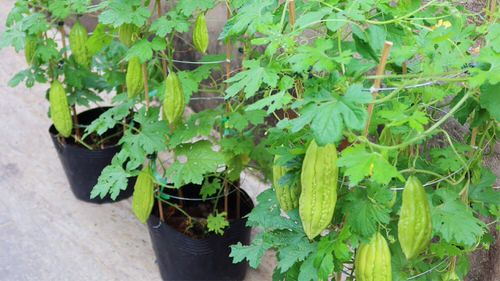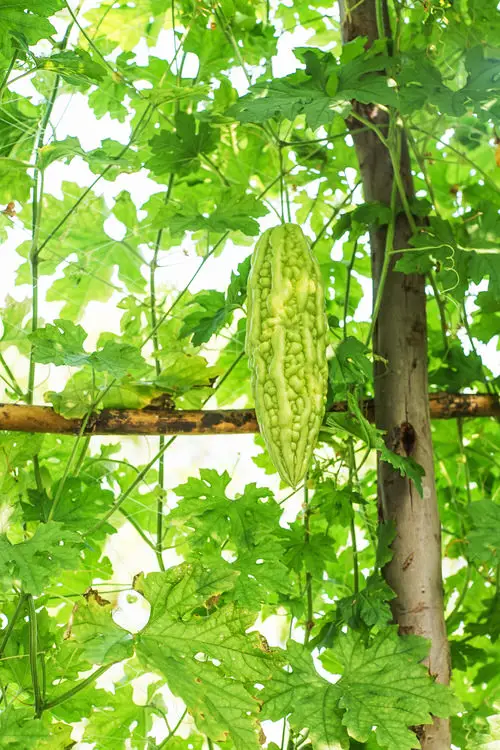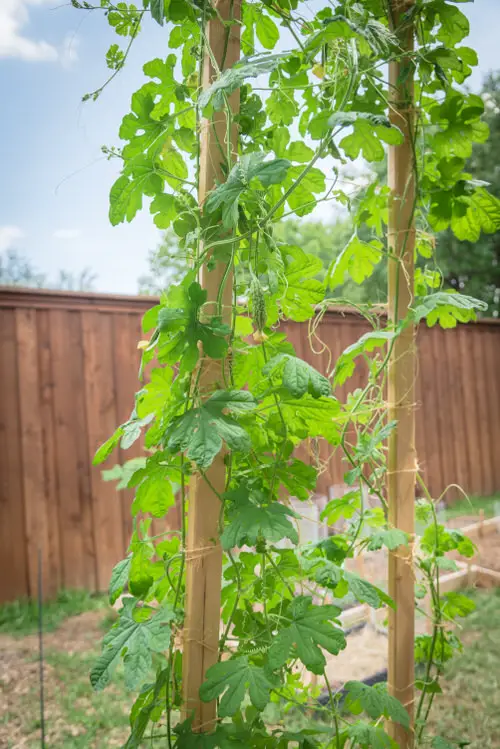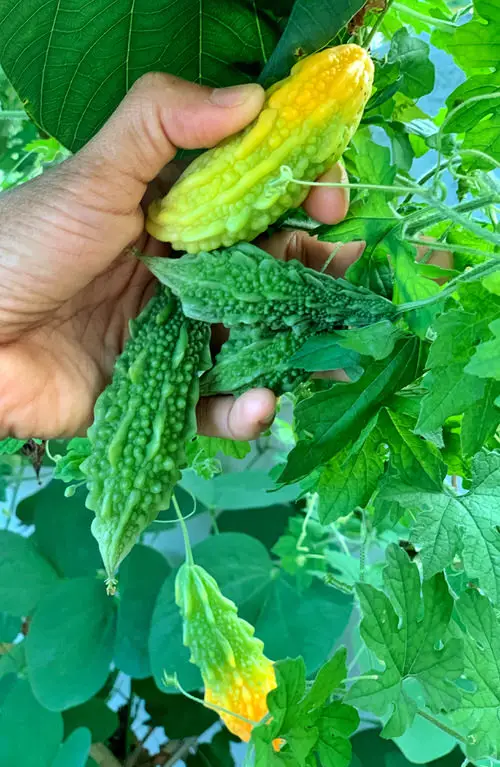Learn How to Grow Bitter Melon in pots easily! It is fun and Growing Bitter Gourd this way will produce ample harvest for your family!

Like cucumber, melon, or pumpkin, it belongs to the gourd family. A native of the Indian subcontinent, it is used in many Asian delicacies! Let’s look at How to Grow Bitter Melon the right way!
USDA Zones: 6-11
Difficulty: Easy
Learn about growing cucamelon in pots here
Common Names of Bitter Melon
African Cucumber, Ampalaya, Balsam Pear, Balsam-Apple, Balsambirne, Balsamo, Bitter Apple, Bitter Cucumber, Bitter Gourd, Bittergurke, Carilla Fruit, Carilla Gourd, Cerasee, Balsam Pear, Balsam-Apple, Balsambirne, Balsamo, Bitter Apple, Bitter Cucumber, Bitter Gourd, Bittergurke, Carilla Fruit, Carilla Gourd, Cerasee, Chinli-Chih, Cundeamor, Fructus Mormordicae Grosvenori, Karavella, Kathilla, Karela, Kareli, Kerala, Kuguazi, K’u-Kua, Lai Margose, Melón Amargo, Melon Amer, Momordica, Momordica charantia, Momordica murcata, Momordique, Pepino Montero, P’u-T’ao, Sorosi, Sushavi, Vegetable insulin, and Wild Cucumber.
Best Bitter Melon Types and Varieties
There are two types of bitter melons. One is from India, which is smaller in size and has spiny skin, and the other is from China. Chinese bitter melons are milder in taste, generally large and smoothly ridged.
If you want a higher yield, choose the hybrid variety and if you want great taste, go for an heirloom variety.
Want to grow watermelon in pots? Click here
Bitter Melon (Bitter Gourd) Information

This short-living tropical perennial climber with thin stems can grow up to 5 meters in length. Like other plants in this family, it needs support. The stem and lobed leaves are hairy, which helps the plant to climb easily. Bitter melon produces yellow flowers, male and female, which insects pollinate.
The unique bitter-tasting fruits are picked unripe when they are still green or slightly pale. They have delicate skin and can be eaten after cooking. The flesh somewhat resembles a cucumber and contains large crunchy seeds inside.
Learn about the best Asian vegetables you should grow here
How to Grow Bitter Melon?

Germination is not difficult, but there are some tricks to make it faster.
Seeds germinate slowly in 3-4 weeks if you directly sow them without pre-treatment, especially at low temperatures. But to increase the germination rate and speed, you have to scarify them to remove the seed coat.
For this, rub the seeds from one side without doing any damage to the endosperm inside the seed coat. Soaking seeds for 24 hours in water before sowing will also help.
Planting Bitter Melon

Sow seeds 2 cm deep, directly into the ground or in the containers, but only when the risk of frost has passed, and the soil warms up enough. Seeds require a temperature above 70 F (20 C) for germination.
The best seed sowing time in temperate regions is summer, usually between late April and May. Whereas in the tropics (USDA Zone 10, 11), you can start seeds anytime.
How to Grow Bitter Gourd in Pots?

Growing bitter gourd (bitter melon) in pots is easy. Similar to squashes, cucumbers, and melons. You’ll need a 12-16 inches deep pot and a sturdy trellis. However, the bitter melon vine can grow more than 5 m (16 feet) long.
A trellis or any other support structure at least 5-6 feet tall is required. Once the vine has reached that height, you’ll have to redirect it.
Learn about growing kiwano melon in pots here
Requirements for Growing Bitter Melon

This plant is cultivated in the same manner as squashes, melons, or cucumbers. However, the fruits are not heavy!
Position
Provide full sun to this vine, and it will produce profusely. Also, as it is a tall vine, you will need to support it with a tall trellis or a garden fence.
If you want to grow it on your patio, terrace, or balcony, grow it near the wall so it can go up along.
Soil
It tolerates a wide range of soils but prefers permeable, sandy loam soil rich in organic matter. Bitter melon grows in slightly acidic to slightly alkaline soil. The pH range of around 6 to 7.1 is ideal.
Watering
It can tolerate drought-like conditions for a short time, but regular watering to keep the soil evenly moist is essential to ensure a good yield.
Temperature
In the initial growth phase, bitter gourds require a temperature of more than 70 F (20 C). Humid and warm temperatures accelerate the growth of the plant.
It is more resistant to low temperatures than other plants of this family but requires hot temperature and humidity to grow, especially in the beginning.
Bitter Melon Plant Care

Fertilizer
Overusing nitrogen-rich fertilizers should be avoided, which could encourage foliage development at the expense of fruits.
When planting, you can mix slow-release fertilizer in the soil. Enriching the soil with compost or well-rotted aged manure and regular organic matter inputs will be enough later.
Still, if your plant is not growing well, you can feed it with liquid fertilizer once a month.
Trellising
Bitter gourd perks up very quickly, and within two weeks after planting, you must arrange something to support it. You can also grow this vine on pergolas, arches, or mini arbors.
Growing bitter gourd vertically increases the yield and fruit size; moreover, in the case of growing horizontally on the ground, there is a high risk of fruit rot and fungal infection to the plant.
Pruning
The plant produces numerous side shoots, which must be removed to improve yield. Remove the side shoots (lateral branches) until the runner reaches the top of the trellis.
Leave only 4–6 laterals and cut the tip of the main runner to improve the productivity of the plant.
Overwintering
Bitter melons are usually grown annually, so you may not need to care about overwintering.
Pollination
Pollinators like bees do the pollination for you, be kind to them. If you don’t find pollinators around the flowers, you may need to hand pollinate them in the morning.
Pests and Diseases
It is prone to diseases like watermelon mosaic virus, other cucurbit diseases, and powdery mildew. In pests, it gets affected by aphids and spider mites.
Want to make organic insecticide at home? Click here
Harvesting Bitter Melon

Bitter melon starts to fruit in 2-3 months. Harvest fruits when green, a little pale, unripe, and about the size of 3 to 6 inches (depending more on the variety and type).
Within 6 to 8 weeks after germination, you’ll see the blossoms, and in the next 2-3 weeks, fruits will appear and ready to be picked.



Very good information for growing bitter gourd. information will be very usefull for me. I have already planted on roof top in two pots.
Thankyou for the information i hv already grown in a bit n hoping for better yield.
Thankyou
Good information..
thank you
Thanks for this information, its indeed helpful. i didn’t know how to grow this, but i’m going to try growing it.
i want to place order for bitter guard seeds. pl help]
I just threw a few seeds into an old unused flower pot and covered it carelessly with soil that was already in the pot,(while I was cutting the vegetable after taking out the pulp and seeds) and it germinated. Best surprise of my life when I saw it after a few weeks.
Thank you for the information, it was very useful.
I live in CT, so I guess I will plant mine in late April. Thank you!
Found this very informative, thanks for sharing!
I am in the Algarve Portgual. As it is August will plant them initially in pots as the growing season will extend to November, December and this way I can protect them from temperatures dipping to 8-9c during winter. We did have frost last year first time in 30 years. I suppose the best time to plant the seed would be April or May? The zone here is 10 A.
Thank you for your response!
How many plant/seedling per pots?